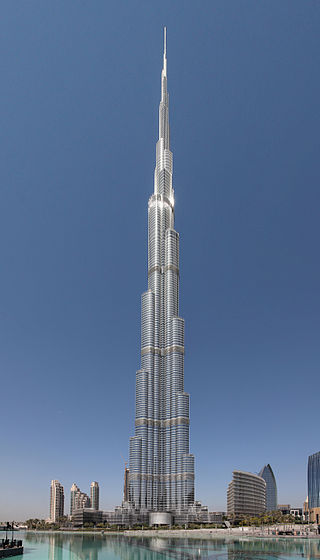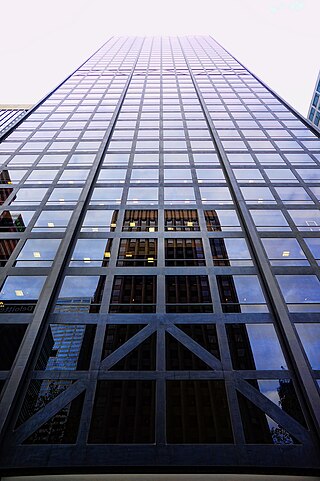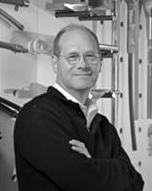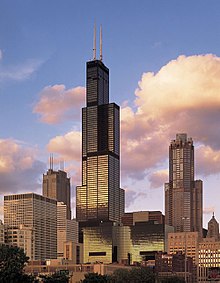
A skyscraper is a tall continuously habitable building having multiple floors. Modern sources define skyscrapers as being at least 100 meters (330 ft) or 150 meters (490 ft) in height, though there is no universally accepted definition, other than being very tall high-rise buildings. Historically, the term first referred to buildings with between 10 and 20 stories when these types of buildings began to be constructed in the 1880s. Skyscrapers may host offices, hotels, residential spaces, and retail spaces.
Leslie Earl Robertson was an American engineer. He was the lead structural engineer of the Twin Towers of the original World Trade Center in New York City, and served as structural engineer on numerous other projects, including the U.S. Steel Tower in Pittsburgh, Shanghai World Financial Center, and the Bank of China Tower in Hong Kong.

The Chicago School refers to two architectural styles derived from the architecture of Chicago. In the history of architecture, the first Chicago School was a school of architects active in Chicago in the late 19th, and at the turn of the 20th century. They were among the first to promote the new technologies of steel-frame construction in commercial buildings, and developed a spatial aesthetic which co-evolved with, and then came to influence, parallel developments in European Modernism. Much of its early work is also known as Commercial Style.
A load-bearing wall or bearing wall is a wall that is an active structural element of a building, which holds the weight of the elements above it, by conducting its weight to a foundation structure below it.

Southeast Financial Center is a two-acre development in Miami, Florida, United States. It consists of a 765 feet (233 m) tall office skyscraper and its 15-story parking garage. It was previously known as the Southeast Financial Center (1984–1992), the First Union Financial Center (1992–2003) and the Wachovia Financial Center (2003–2011). In 2011, it retook its old name of Southeast Financial Center as Wachovia merged with Wells Fargo and moved to the nearby Wells Fargo Center.

Fazlur Rahman Khan was a Bangladeshi-American structural engineer and architect, who initiated important structural systems for skyscrapers. Considered the "father of tubular designs" for high-rises, Khan was also a pioneer in computer-aided design (CAD). He was the designer of the Sears Tower, since renamed Willis Tower, the tallest building in the world from 1973 until 1998, and the 100-story John Hancock Center.

Steel frame is a building technique with a "skeleton frame" of vertical steel columns and horizontal I-beams, constructed in a rectangular grid to support the floors, roof and walls of a building which are all attached to the frame. The development of this technique made the construction of the skyscraper possible.

The design and construction of skyscrapers involves creating safe, habitable spaces in very high buildings. The buildings must support their weight, resist wind and earthquakes, and protect occupants from fire. Yet they must also be conveniently accessible, even on the upper floors, and provide utilities and a comfortable climate for the occupants. The problems posed in skyscraper design are considered among the most complex encountered given the balances required between economics, engineering, and construction management.
The term structural system or structural frame in structural engineering refers to the load-resisting sub-system of a building or object. The structural system transfers loads through interconnected elements or members.

140 William Street is a 41-storey 152m tall steel, concrete and glass building located in the western end of the central business district of Melbourne, Victoria, Australia. Constructed between 1969 and 1972, BHP House was designed by the architectural practice Yuncken Freeman alongside engineers Irwinconsult, with heavy influence of contemporary skyscrapers in Chicago, Illinois. The local architects sought technical advice from Bangladeshi-American structural engineer Fazlur Rahman Khan, of renowned American architectural firm Skidmore, Owings & Merrill, spending ten weeks at its Chicago office in 1968. At the time, BHP House was known to be the tallest steel-framed building and the first office building in Australia to use a “total energy concept” – the generation of its own electricity using BHP natural gas. The name BHP House came from the building being the national headquarters of BHP. BHP House has been included in the Victorian Heritage Register for significance to the State of Victoria for following three reasons:

The Onterie Center is a sixty-story award-winning high rise in downtown Chicago, Illinois, United States. It is located at 441 East Erie St, and takes its name from a conflation of "Ontario" and "Erie", the streets at its two entrances.

The history of structural engineering dates back to at least 2700 BC when the step pyramid for Pharaoh Djoser was built by Imhotep, the first architect in history known by name. Pyramids were the most common major structures built by ancient civilizations because it is a structural form which is inherently stable and can be almost infinitely scaled.

Progressive collapse is the process where a primary structural element fails, resulting in the failure of adjoining structural elements, which in turn causes further structural failure.

William Frazier Baker is an American structural engineer known for engineering the Burj Khalifa, the world's tallest building/man-made structure and a number of other well known buildings. He is currently a structural engineering partner in the Chicago office of Skidmore, Owings & Merrill, LLP (SOM).

X-bracing is a structural engineering practice where the lateral load on a building is reduced by transferring the load into the exterior columns.
Moment-resisting frame is a rectilinear assemblage of beams and columns, with the beams rigidly connected to the columns.
Signature Tower was a proposed skyscraper in Jakarta, Indonesia. The proposed height is 638 m (2,093 ft).

Tianjin CTF Finance Center is a super-tall skyscraper located in the Tianjin Economic-Technological Development Area central business district of Binhai, Tianjin, China. Construction started in 2013 and was completed in 2019. At 1,739 ft (530 m), and with 97 floors, the tower is the second-tallest building in Municipal Tianjin after Goldin Finance 117, the eighth-tallest building in the world, and the tallest building in the world with fewer than 100 floors. It is located in the outer district of the Tianjin Economic-Technological Development Area. Tianjin CTF Finance Center is designed by Skidmore, Owings & Merrill LLP in collaboration with Ronald Lu & Partners.

Shum Yip Upperhills Tower 1 is a supertall skyscraper completed in Shenzhen, Guangdong, China. It stand at 388.1 metres (1,273.3 ft) tall. Construction started on 12 February 2014 and was completed in 2020.

The Cook County Administration Building is a skyscraper located at 69 West Washington Street in Chicago, Illinois. The building, constructed between the years 1962 and 1964, is 475 ft tall, and contains 35 floors. It has a concrete structure. The building, engineered by Fazlur Khan of the firm Skidmore, Owings & Merrill, is notable for innovating the tube-within-a-tube structural system.



















